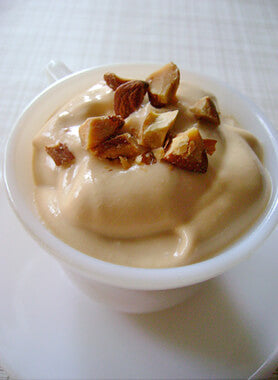Tea Infused Cultured Yogurt Recipe
Commercially available yogurts are usually heavily sweetened, sometimes artificially colored, and often excessively priced. Making your own is economical and a good way to avoid highly processed sugar, while providing boundless options to be creative with flavors. Lately, I’ve been perusing Arbor Teas’ line of organic loose leaf herbal and rooibos teas for inspiration in my yogurt making. Flavors I’ve made include Crimson Berry Fruit Tisane (my hands-down absolute favorite) and Vanilla Almond Rooibos (pictured to the right). Albeit tart, yogurt provides an impeccably blank canvas for the flavor of even the most delicate tea to stand out resoundingly.
Using a yogurt maker* undeniably streamlines the entire process, making things easier by automatically maintaining the proper incubation temperature. However, if you are like me and don’t own an automatic yogurt machine, then follow the steps I’ve outlined below. As with most things, your first batch is always the hardest, but once you get the method down, it feels like such an accomplishment to be able to create this healthy staple in your own kitchen. Tea-flavored yogurt has yet to hit the supermarket shelves. Why not impress your friends with something completely unique and entirely wholesome?
Makes ~1 quart of yogurt
Ingredients
- 1 quart (4 cups) milk (any kind will work including whole milk, 2%, 1%, skim, pasteurized, homogenized, organic, raw, diluted evaporated, dry powdered, cow, goat, soybean, etc)
- 2 TBS existing yogurt with live “active” cultures, or powdered yogurt starter (freeze- dried bacteria cultures such a Yogourmet); this is the starter
- 3-4 TBS organic loose leaf tea
Directions
* If you are using a yogurt maker, follow the instructions from the manufacturer. Incorporate the sachet of tea as described below during the heating and cooling of the milk. Remove the sachet before adding your starter/culture.
Warm the starter. Let the starter yogurt sit at room temperature while you are waiting for the milk to heat and then cool. This will prevent it from being too cold when ready to add it in.
Pack loose tea in sachet. Add 3-4 tablespoons of loose leaf tea to a disposable filter and tie off with kitchen twine. Allow this sachet to float in the milk during the next two steps of heating and cooling.
Heat milk to 185° F. Using two pots that fit inside one another, create a double boiler or water jacket effect by filling the outer pot with water up to the level surface of the milk in the inner pot. This will prevent your milk from burning, and you should only have to stir it occasionally to prevent a skin from forming on the surface. If you cannot do this, and must heat the milk directly on the burner, be sure to monitor it constantly, stirring all the while. If you do not have a thermometer, 185° F is the temperature at which milk starts to froth. This should take 25-30 minutes.
Cool the milk to 110° F. The best way to achieve this is with a cold water bath, such as a kitchen sink filled with ice water. This will quickly (~4-minutes), and evenly, lower the temperature, and requires only occasional stirring. If cooling at room temperature or in the refrigerator, you must stir more frequently. Don’t proceed until the milk is below 120° F, and don’t allow it to go below 90° F. 110° F is optimal.
Add the starter. Remove the tea sachet and add 2 tablespoons of the existing yogurt, such as store-bought plain yogurt. Be certain it says “active cultures” on the label. Alternatively, instead of existing yogurt you can purchase powdered yogurt starter (freeze-dried bacteria cultures) at your local grocery store, which are often more reliable.
Put the mixture in containers. Pour your milk into a clean container and cover tightly with a lid.
Allow the yogurt bacteria to incubate. Keep the yogurt warm and still to encourage bacteria growth, while keeping the temperature as close to 100° F as possible. The best way to do this is to carefully pour the steaming water from the double boiler into an insulated cooler. Allow the water temperature to cool down to around 100° F before adding the container of yogurt. I use a mason jar lying on its side to prop the yogurt container above the water level. Keep the cooler tightly shut and refrain from disturbing during the entire incubation process. Keeping the yogurt still is important to allow the culture to develop properly.
Other options include placing atop a heating pad or in an oven with a pilot light. If your oven doesn’t have a pilot light but does have an oven light, preheating the oven to the desired temperature, turning it off, and then leaving the oven light on to maintain the temperature may work for you. Another method is to turn your oven on and then off again periodically, being vigilant that it doesn’t get too hot. To check the oven temperature, you can set a candy thermometer in a bowl of water inside the oven. Other methods for keeping the yogurt warm include: hot water in a sink, a stove burner, a crock-pot, or a warming tray. Just use your thermometer, trial and error, and best judgment. Maintaining the proper incubation temperature is key to successful yogurt culturing. Admittedly, in a chilly winter home, I’ve had little success with most of the above techniques, except for the cooler method.
After eight or more hours incubation, you will have a custard-like, curdled texture, a sour, fermented odor, and a separation of whey (a thin yellow liquid) on top. This is exactly what you want. The longer you let it incubate, the thicker and tangier the yogurt will become.
Refrigerate the yogurt. Place the yogurt in the fridge for several hours before serving. I prefer a thicker texture akin to greek or skyr-style yogurt, so will strain the whey from a fresh batch. This can be achieved by using a specific canister designed to make yogurt cheese or by using a sieve, lined with several layers of cheesecloth, set over a bowl. Fresh yogurt will keep for 1-2 weeks. If you plan to use some of it as starter for your next yogurt making session, use it within 5-7 days, while the bacteria is most potent. If not strained, whey will rise to the surface. You can pour this off or stir it in before eating. Whey contains healthful nutrients. A decision to discard it completely should not be taken lightly.
Recipe by Olivia May


